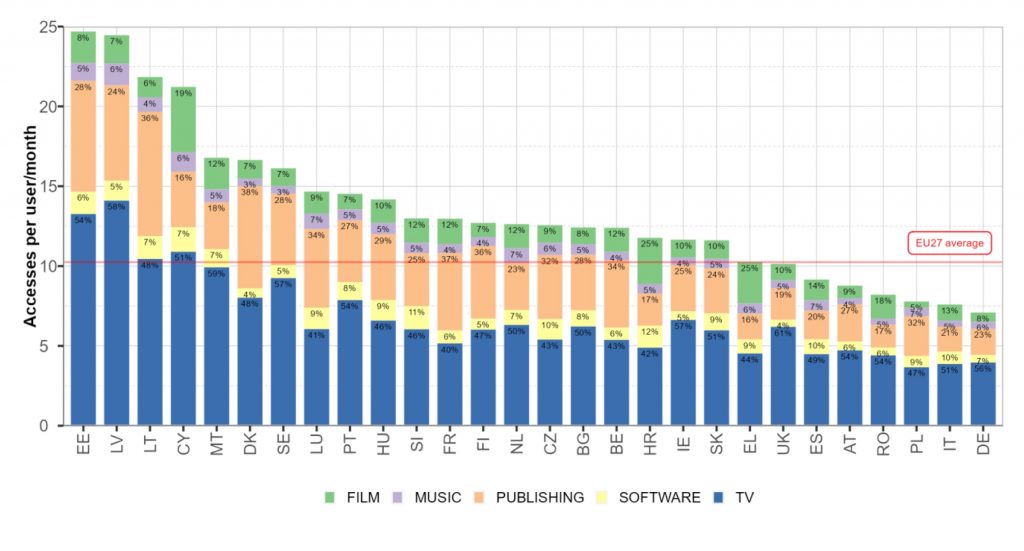 The EUIPO measured the number of monthly accesses per Internet user to copyright-infringing content in the 27 EU Member States for TV, music and film during the period 2017-2022, it found digital piracy increased by 3.3 %. The study found piracy drivers to be the cost and availability of legal services, economic conditions, and the degree to which there are permissive attitudes are about piracy.
The EUIPO measured the number of monthly accesses per Internet user to copyright-infringing content in the 27 EU Member States for TV, music and film during the period 2017-2022, it found digital piracy increased by 3.3 %. The study found piracy drivers to be the cost and availability of legal services, economic conditions, and the degree to which there are permissive attitudes are about piracy.
At 48% of the total, TV content is the most pirated type of content in the EU, followed by online publications (28%), film (11%), software (7%) and music (6%). Piracy of live events, such as streaming of sports games, is also on the rise.
TV piracy rates EU-wide had reached 6.5% during 2017 but had fallen below 4% by the outset of the COVID pandemic in early 2020. During 2020 again rose above 4% but fell back below 4% later in that year. By 2021 TV piracy had begun its current rise to about 4.5%. Piracy rates for TV programming were highest in Estonia and Latvia, and lowest in Germany, Italy and Poland.

The trend-line for Film content experienced a similar story-arc from 2017 through 2022, rising as the COVID pandemic ebbed. Only music piracy has continued its decline through 2022. Overall, 58 % of piracy in the EU occurring via streaming and 32 % through downloading.
Piracy of live sports events showed an upward trend in 2021 to 2022 with a 30% increase. Sports live event piracy has been steadily increasing, from a 2021 average of 0.42 accesses per user per month to 0.55 accesses in 2022, which represents a 30 % increase in only one year. Seasonal fluctuations in piracy appeared to reflect sports seasons and summer breaks.
Methodology
The consumption of pirated digital content is defined as the average number of ‘activities’ per internet user per month in each country and period. Access methods were segmented into streaming, torrents, downloading and stream-ripping.
Content was segmented into TV, films, music, software and publications. It was further segmented into genre, platform of access (mobile and computer), and traffic sources (direct, social, search engine result, referrals, and display ads).
The basic data for this study comes from tracking traffic to piracy websites, sourced from MUSO, which provided data on such activity for the period 2017 to 2022. Additional data were sourced from official databases such as EUROSTAT, and from the EUIPO IP Perception studies to better understand the mechanisms behind piracy:
- Economic and social variables such as per capita gross domestic product (GDP), inequality (Gini index), population structure and youth unemployment.
- Perception, awareness and behaviour in respect of piracy as reported by respondents in the IP Perception study.
- Volume of the legal offer which was obtained from the MAVISE database and Pro-music.
Further details
This is the third study on the evolution of web-based online copyright infringement, designed to inform the strategies and policies used to combat piracy and support the growth of the digital content industry. The study examines the number of accesses to pirated films, TV, music, software and publications from January 2017 to December 2022, using a variety of desktop and mobile access methods, such as streaming, downloading, torrents and stream ripping software. The new edition includes two content types not previously studied, publications and software, although only for 2021 and 2022.
Access the report
Online Copyright Infringement in the European Union, Films, Music, Publications, Software and TV, 2017-2022. Report. September 19, 2023. European Union Intellectual Property Office (EUIPO)
Why it matters
Speaking about the study, the EUIPO’s Executive Director, Christian Archambeau, emphasised copyright infringement in the digital era as a serious concern and a direct threat to the creative industries in Europe.
“The new study shows that there is still much work to do to tackle piracy. Stopping this phenomenon is complex as piracy is continuously evolving with technology. This is why understanding the underlying mechanisms of piracy is essential to adopt effective policies and measures that contribute to reducing it,” he said.












